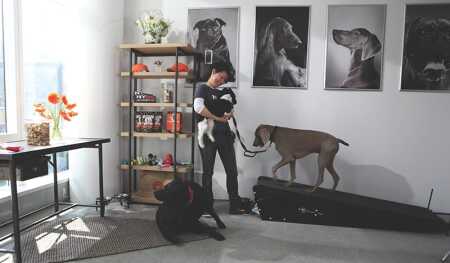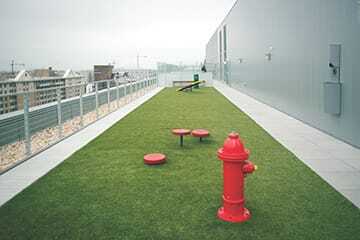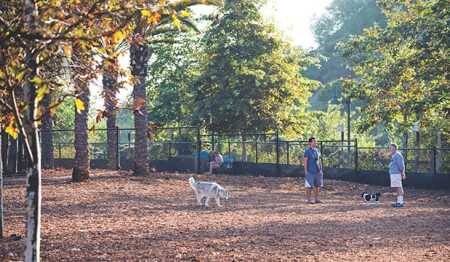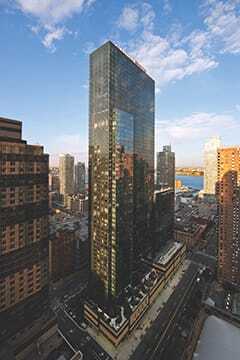Third North Apartments opened in downtown Minneapolis in December with the usual modern amenities to attract high-end tenants: underground parking, a swimming pool, an outdoor fire pit, a fitness center, and a private party room, plus stainless-steel appliances and granite-topped kitchen islands. But the building also features something a little more unusual to stand out in the marketplace: a dog-washing room.
It is a small room off the garage that includes a stainless-steel tub with a sprayer hose alongside a table with a blow-dryer. So far in Third North’s young life, management has determined that 55 percent of the tenants have pets, so the dog-washing station gets used every day.
“When we’re showing the building to prospective tenants, nine out of ten times we’ll be asked if we’re pet friendly,” says property manager Mary Swanson. “It gives us an advantage because we have a few more amenities than some of the communities in our area.”
Welcome to a new frontier in multifamily housing: pet-friendly accommodations. Cities have been developing dog parks for years, and the retail industry has long catered to our four-legged friends with doggy daycare, dog clothing, and even yoga classes that people can take with their dogs. Finally, the real estate industry is beginning to catch up. Apartment and condominium developers from New York City to Washington state are incorporating pet amenities like grooming stations, day boarding facilities, dog-walking services, veterinary clinics, miniature dog parks, and even rooftop dog walks with special cleaning systems.
“One of the ways to be successful in this business now is you have to be pet friendly. It creates a larger target market for your community,” says William MacDonald, chief investment officer for apartment owner Mill Creek Residential in Maryland and chairman of ULI’s Multi-Family Council (Gold Flight).
This trend took off as real estate recovered from the Great Recession. According to developers and market observers, a new wave of multifamily projects started to cater to populist lifestyles. Out went frou-frou features like cigar and wine rooms, and in came more social and communal amenities like craft rooms, gardens, and pet spaces. Some industry research has found that about 10 percent of apartment or condo residents will consistently use a fitness center, and fewer than that will use a community or party room. But pet amenities tend to be used every day, and sometimes more than once.
“What has changed is the mind-set of developers,” says Marian Schaffer, founder of Southeast Discovery, a web portal for retirement and second-home real estate. “Prior to ’07, the buzz was who could build the biggest clubhouse and pool, who could wow the consumer the most. Today, it’s all about what’s most practical and what will be used the most.”
Denver-based urban apartment developer UDR has been at the forefront of providing pet-friendly features. Jerry Davis, the company’s chief operating officer, estimates that almost half of UDR’s renters nationwide have a pet, so one-third of the company’s new developments since 2007 have included some pet accommodations. One such development is downtown Seattle’s Olivian, a 27-story high rise with an artificial-turf pet park on the 26th floor’s outdoor terrace, plus a 6,000-square-foot (557 sq m) ground-floor retail space called Citydog that offers boarding, grooming, and five indoor pet play spaces.
“It’s like dropping your kid off at daycare,” Davis says of City Dog. “It’s a huge amenity and it’s also a way to attract more residents.”

Minneapolis’s Third North Apartments, a luxury building with 117 units, has a dog-washing room off the underground parking garage that includes a stainless steel tub for washing and a table for drying and grooming. Prospective tenants sometimes bring their pets to check out the building’s amenities, which include an outdoor dog run. (Third North Apartments and Tom Witta)
Becoming Welcoming
Not long ago, many apartment and condominium buildings did not want to attract residents who had pets. Plenty of properties banned pets outright. But that has been slowly changing, driven by record levels of pet ownership and shifting U.S. demographics, in which the ranks of empty nesters are growing and more young people are getting married later and delaying having children. Pets are filling the voids of companionship.
In the United States, pet ownership has been steadily rising for decades. The number of households owning at least one pet jumped 35 percent during the past decade to 74.1 million, according to the U.S. Pet Ownership & Demographics Sourcebook, published by the American Veterinary Medical Association. Dogs are America’s favorite pet, with 43.3 million households owning one, and dog ownership is surging among singles and renters.
From 2006 to 2011, the latest year for which data are available, dog ownership increased 39 percent among women living alone, 48 percent among men living alone, and 46 percent among apartment renters, the association found.
America’s obsession with pets is hardly new. What is new is the multifamily industry’s response. A decade ago, a survey of tenants across the country by the Foundation for Interdisciplinary Research and Education Promoting Animal Welfare found 82 percent of pet-owning respondents had trouble finding a rental unit that welcomed pets. “The lack of available pet-friendly rental housing is puzzling when one considers the high numbers of U.S. households with companion animals,” the Massachusetts-based foundation concluded in a 2005 report.
“I’m not sure as an industry that we’ve done the best job in the past of catering to pet owners,” says Sean Breslin, chairman of ULI’s Multi-Family Council (Blue Flight) and executive vice president for investments at AvalonBay Communities, an apartment developer and manager based in Arlington, Virginia. “Now the younger generation has more pets, and they put more value on the social interaction that comes with having pets.”
In Washington, D.C., when Roadside Development was planning a multi-block apartment complex called City Market at O, it held focus groups with people under 35 years old. Based on that feedback, Roadside included amenities like a grocery store, a game room, outdoor fire pits—and a rooftop dog park that is 200 feet (60 m) long with separate sections dedicated to dogs of different sizes. A dog-washing station is nearby.
“We wanted to differentiate ourselves,” says Richard Lake, a partner in Roadside, which opened City Market at O late last year. “Having these amenities will keep tenants here longer.”Claudia Gerster, principal with Phoenix-based Creative License International, helps residential developers with branding for new projects. “When we worked with multifamily developers ten years ago, it was, ‘We don’t allow pets,’” says Gerster, who is also a vice chair of ULI’s Community Development Council (Blue Flight). “Now being pet friendly is part of our conversation.”
Dog Pools and Cat Rooms
Whereas the United States has been a bit behind the curve on pet friendliness, it has long been the rage in Japan. There, special dog doors and scratch-resistant flooring are common. Japan’s Fauna+Design remodeled one small Japanese home to accommodate a large Labrador retriever by placing a children’s playroom on top of an indoor kennel; FORM/Kouichi Kimura Architects of Japan created an under-house dog space reached from the backyard that resembles an American walk-out basement, only for a dog.
In the United States, pet-friendly additions are turning up in the single-family sector, too, both outside and inside homes. Master-planned communities have added dog parks as a must-have convenience. The Hampton Lake community, near Hilton Head Island in South Carolina, has Dogpaddle Park—a fenced park with sand pits, dirt mounds, and even a red fire hydrant with a shower to help Fido cool off. Brookfield Residential’s Playa Vista, a decade-old mixed-use community outside Los Angeles with 7,000 residents, has added two dog parks, and two more are planned.
“It’s definitely a competitive advantage to be so welcoming for dogs,” says Alison Banks, marketing director for Brookfield Residential.
More than Millennials
ProMatura, a Mississippi-based real estate research and advisory firm specializing in age-qualified housing, surveys seniors every year on what they want in their housing communities. In last year’s survey, 43 percent of respondents indicated they thought a dog park was essential or desirable, up from 33 percent the previous year.
“Five years ago, it was rare that we’d even think about asking about a dog park,” says Margaret Wylde, ProMatura’s chief executive officer and chair of ULI’s Senior Housing Council. “Now, almost every developer is thinking about a dog park. They’ve become much more a staple in communities.”
Meanwhile, architects and contractors are increasingly incorporating pet amenities in the design of individual homes. Among these features are rooms with pet-sized furniture, custom-built cabinets for food bowls—even nooks with heated window seats. Rhona Sutter, a Florida real estate agent, says she has shown a house with a dog pool separate from the people pool.
“It’s quite amazing what some people are doing now and what they are demanding,” says Sutter, who runs a series of websites called the Pet Realty Network to help people find pet-friendly housing. “It’s something buyers really think about now when they build. Pet friendly has come into the forefront of consideration.”
As for other pets, homebuilder Brookfield Residential has introduced a “cat room” option in La Vita, its new Irvine, California, neighborhood. The room, part of a laundry room, features a specially designed cabinet with space for a litter box and supplies, all confined behind a curtain for felines that prefer privacy. The idea came from Brookfield senior marketing director and pet owner Mercedes Meserve. “I know from experience after remodeling my own home that it’s important to accommodate the needs of all members of the family, so to speak,” Meserve says.
Pet Profits
Still, it is in the multifamily sector where pet accommodations are making the biggest splash, and more accommodations cater to dogs because they require more services.
The Austonian, a 56-story luxury condominium high-rise in Austin, Texas, has a dog-grooming room and a 600-square-foot (56 sq m) outdoor dog park on a tenth-floor terrace. A midtown Manhattan high rise called MiMA has a dog-only pool in the shape of a bone, plus several pet services bundled together in an interior complex called Dog City, providing everything from dog playgrounds to dog play dates, from behavioral training to geriatric care for elderly dogs.
The concept for Dog City emerged after MiMA’s owner, Related Companies, determined from tenant research in its other high rises that 60 percent of residents have a dog. “You’re always looking at the data from your buildings and challenging yourself: ‘What can we do that’s better?’” says Daria Salusbury, Related senior vice president of leasing. “For MiMA, we really drilled down to what’s important to residents with a dog.”
Pet accommodations, like any amenity, do incur extra upfront investments and maintenance costs. Some buildings add insulation between walls and floors to muffle pet noises, particularly barking, and a grooming room with a tub and running water can cost a few thousand dollars to build. Many of the rooftop dog parks are made of porous artificial sod with drainage and sprinkler systems both above and below the sod. The sprinklers are turned on several times a day to wash away any waste and odors.
But properties recover these expenses with special pet fees. At the new four-story Savier Street Flats in downtown Portland, Oregon, pet owners put up a $300 deposit and then pay an extra $40 monthly fee. At City Market at O in Washington the additional deposit is $500 for one pet and $800 for two, and the monthly fee is $60. Says Joel Regignano, City Market’s general manager, “The income we get is far more than the cost to maintain or clean up after pets. It’s absolutely a good return on investment.”
Pet-friendly accommodations are now an increasingly popular differentiator in multifamily housing—to the point that some observers wonder whether they will spawn a backlash. After all, not everyone likes hearing a dog barking next door. So, as more housing developments welcome pets, will some other developments pursue a market niche in the other direction, as pet-free?
“There’s potential for a negative backlash, certainly,” says MacDonald. “The last chapter has not been written yet.”
JEFFREY SPIVAK, a senior market analyst in suburban Kansas City, Missouri, has been writing about real estate, development, and infrastructure issues for more than 20 years.








